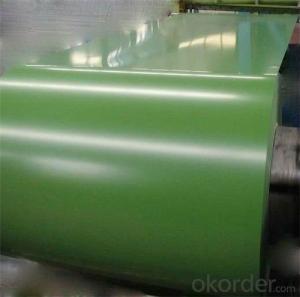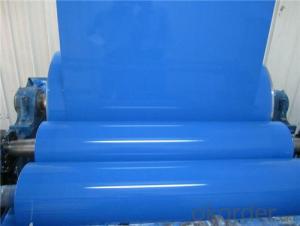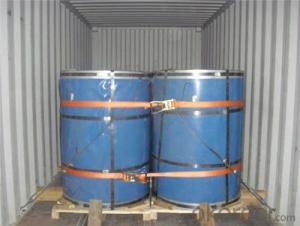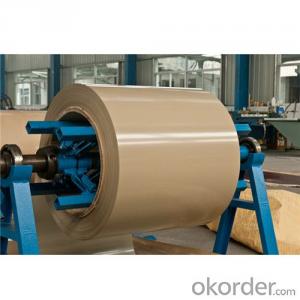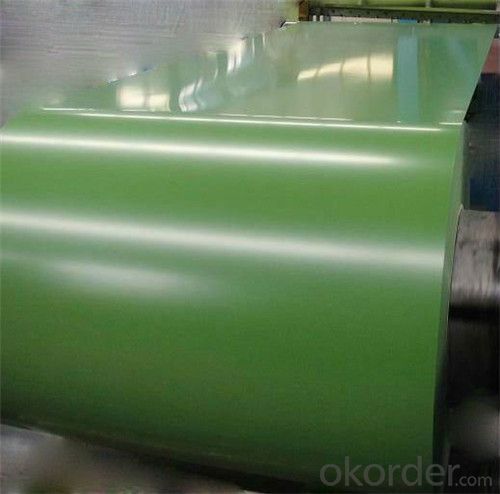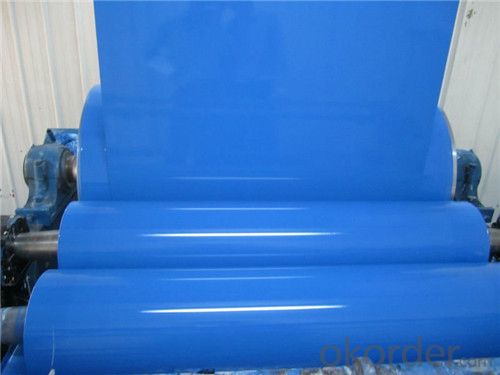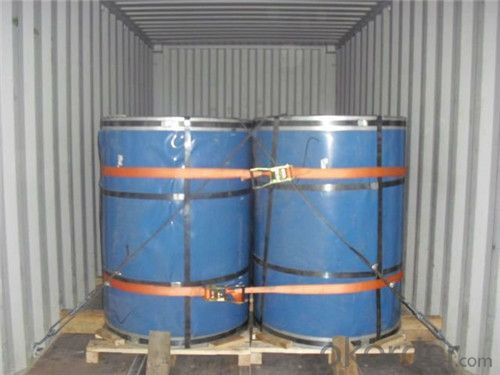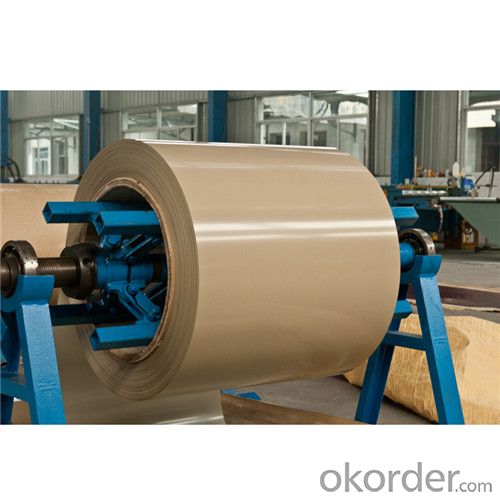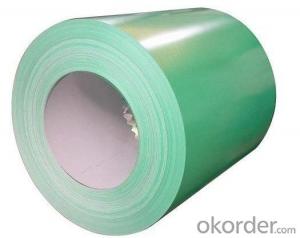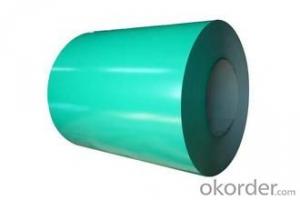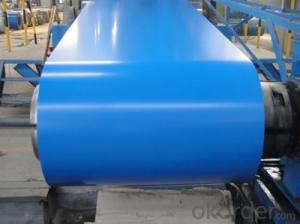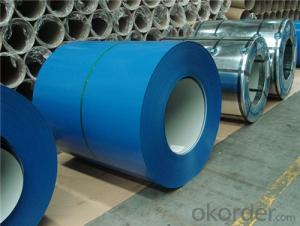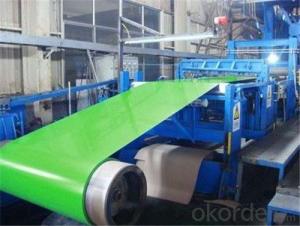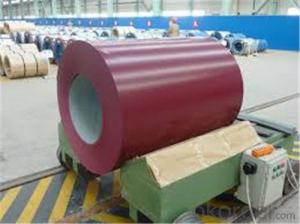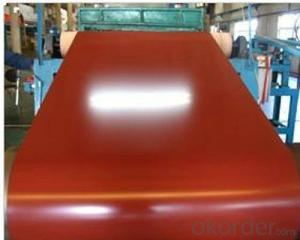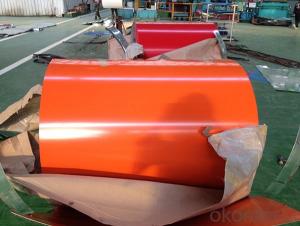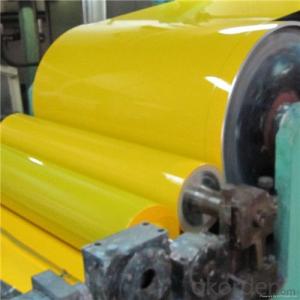Prepainted Rolled Steel Coil for Construction roofing constrution
- Loading Port:
- Shanghai
- Payment Terms:
- TT OR LC
- Min Order Qty:
- 50 m.t.
- Supply Capability:
- 30000 m.t./month
OKorder Service Pledge
OKorder Financial Service
You Might Also Like
Structure of Prepainted Rolled steel Coil for Construction Roofing
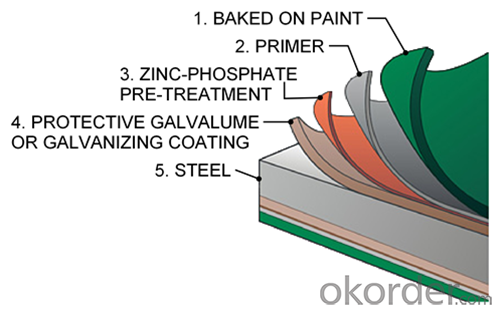
Description of Prepainted Rolled steel Coil for Construction Roofing
Prepainted Rolled steel Coil is a kind of coated steel coil/sheet. With the cold rolled steel of different strength and thickness as substrate, it is produced through applying Al-Zn coat on both faces by hot dip process. In its coating, Al accounts for about 55%, Si 1.6%, while the remaining is Zn. Aluminum zinc coils enjoys both the physical protective feature and durability of Al and the electrochemical protective property of Zn. And its surface has bright silver color and regular embossed-like figure, which are highly decorative.
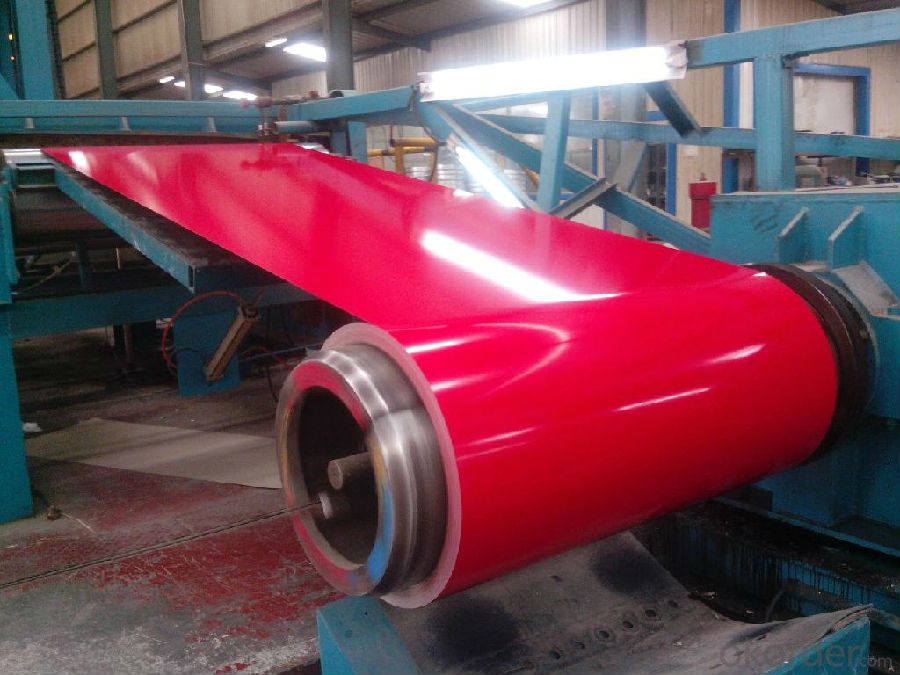
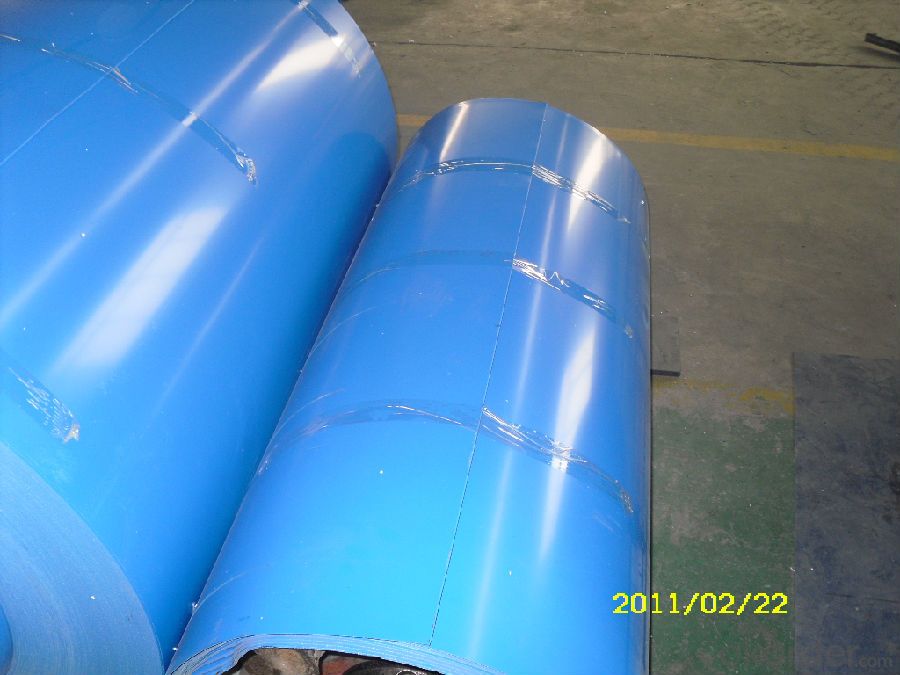
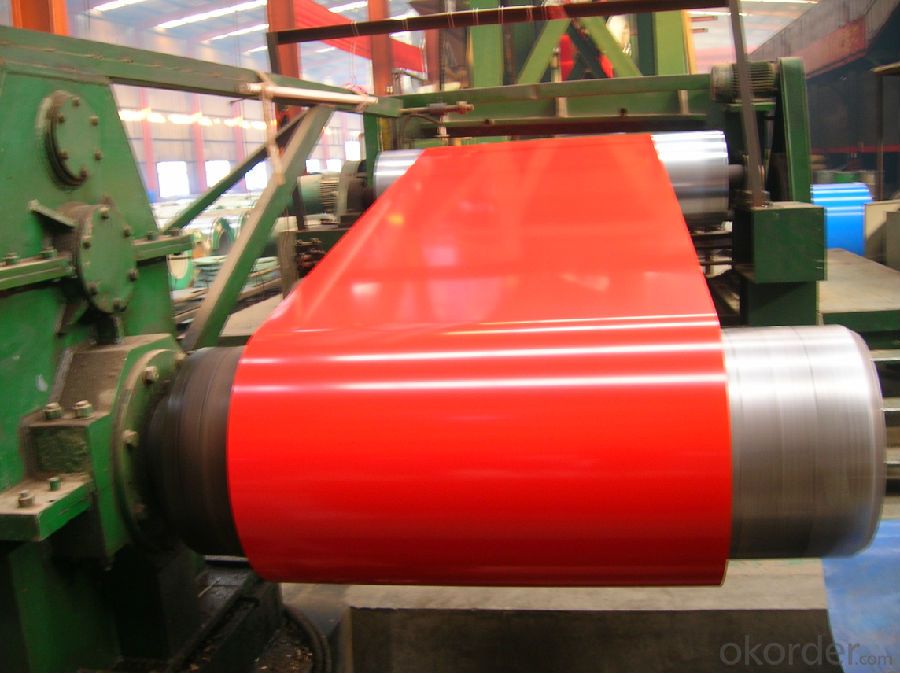
Main Feature of Prepainted Rolled steel Coil for Construction Roofing
1.Corrosion resistance: It mainly depends on the aluminum protection. When the zinc being worn, the aluminum will form a dense layer of aluminum oxide, resist corrosion material to prevent further corrosion inside.
2. Heat resistance: Aluminum zinc alloy steel sheet has excellent heat resistance, can withstand high temperatures over 300 centigrade, and is similar with aluminized steel high temperature oxidation resistance. It often used in chimney pipes, ovens, fluorescent lighting device and the device cover.
3. Heat reflective: Galvanized steel plate heat-reflective high rate is twice as galvanized steel, often used to make insulation materials.
4. Economy: Because density of 55% AL-Zn is smaller than the density of Zn, so in the same weight and thickness of Galvanized zinc layer, aluminum-zinc steel plate is larger area more than 3% of galvanized steel sheet.
Applications of Prepainted Rolled steel Coil for Construction Roofing
1. Construction and building: roofing; ventilating duct; handrail; partition panel;etc.
2. Electric appliance: refrigerator; washing machine; refrigerator; DVD;etc.
3.Transportation: oil tank; road sign; etc.
4.Agriculture:barn; etc.
5.Others:vending machine; game machine; etc.
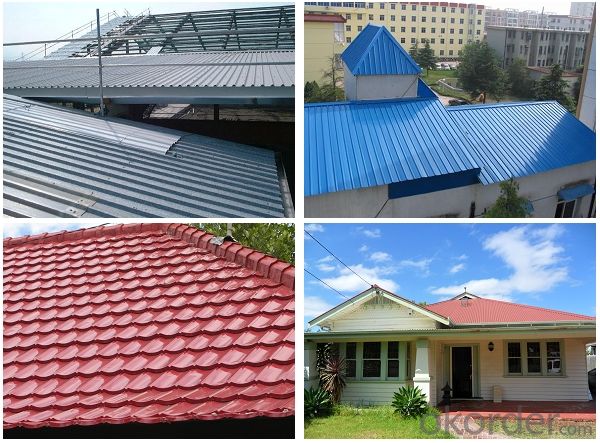
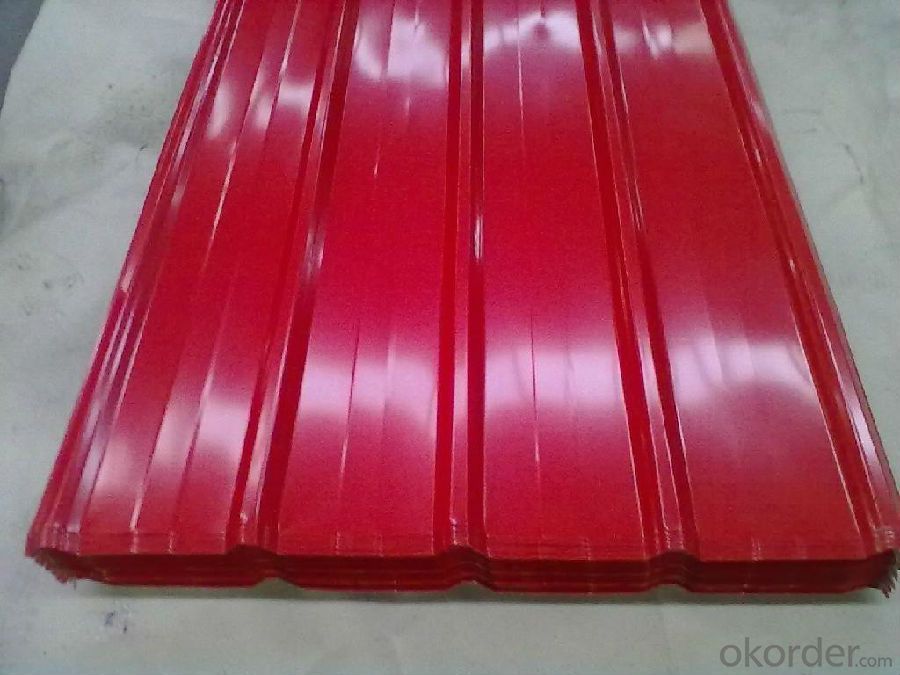
Specifications of Rolled steel Coil for Construction Roofing
Product | Prepainted Rolled steel Coil for Construction Roofing |
Material Grade | SGCC / SGCH / DX51D+AZ, etc |
Thickness | 0.2-3.0mm |
Width | 600-1500mm |
Tolerance | Thickness: +/-0.02mm , Width:+/-2mm |
Zinc-coating | AZ40-150g/m2 |
Technique | Raw material: Hot rolled steel coil --> Cold rolled_>hot dipped galvalume |
Surface | Dried, Chromated, Unoiled |
Spangle | Regular spangle , small spangle, zero spangle |
ID | 508MM |
Coil weight | 10MT max |
Export package | Cardboard inner sleeves, Waterproof paper, galvanized steel covered and steel strip packed |
FAQ of Prepainted Rolled steel Coil for Construction Roofing
We have organized several common questions for our clients,may help you sincerely:
1. What is the minimum order quantity ?
Our MOQ is 50mt for each size. And we will consider to give more discount if you make big order like 1000 tons and more. Further more, the more appropriate payment term your offer the better price we can provide.
2. How long can we receive the product after purchase?
Usually within thirty working days after receiving buyer’s advance payment or LC. We will arrange the factory manufacturing as soon as possible. The cargo readiness usually takes 15-25 days, but the shipment will depend on the vessel situation.
3. How to guarantee the quality of the products?
We have established the international advanced quality management system,every link from raw material to final product we have strict quality test;We resolutely put an end to unqualified products flowing into the market. At the same time, we will provide necessary follow-up service assurance.
- Q: Does steel contain nickel?
- Steel okorder /... So take a magnet to the steel in question: if the magnet sticks, the steel is unlikely to contain nickel.
- Q: How do steel coils contribute to sustainability efforts?
- Steel coils contribute to sustainability efforts in several ways. Firstly, steel coils are made from recycled steel, reducing the need for virgin raw materials and minimizing the environmental impact of mining and processing. Additionally, steel coils are highly durable and long-lasting, meaning that products made using steel coils have a longer lifespan, reducing the frequency of replacements and waste generation. Furthermore, steel is a highly recyclable material, and steel coils can be easily recycled at the end of their life, making them a sustainable choice.
- Q: What are the factors affecting the strength of steel coils?
- The factors affecting the strength of steel coils include the composition of the steel, the manufacturing process used, the temperature and time of heat treatment, the presence of impurities or defects, and the degree of deformation during processing.
- Q: What are the different methods of transporting steel coils?
- There are several methods of transporting steel coils, depending on factors such as the weight, size, and distance of the shipment. Some of the different methods include: 1. Flatbed trucks: Steel coils can be transported on flatbed trucks, which have a large open platform for easy loading and unloading. This method is commonly used for short to medium distance shipments and allows for easy access to the coils. 2. Rail transport: Steel coils can also be transported via rail. Specialized railcars called coil cars are used for this purpose, which have a curved interior to securely hold the coils in place. Rail transport is often used for long-distance shipments, as it is cost-effective and can handle large quantities of steel coils. 3. Shipping containers: Steel coils can be loaded into shipping containers for transportation via sea or inland waterways. The coils are usually secured inside the container using bracing or blocking materials to prevent movement during transit. This method is commonly used for international shipments and allows for easy handling and transfer between different modes of transportation. 4. Barges: In certain cases, steel coils can be transported on barges along rivers, canals, or other inland waterways. Barges are often used for large and heavy shipments, as they offer a cost-effective and efficient mode of transportation. 5. Roll-on/roll-off (RoRo) vessels: RoRo vessels are specialized ships designed to transport vehicles and large cargo that can be rolled on and off the ship. Steel coils can be loaded onto trailers or flatbeds and driven onto the vessel, making it a convenient method for transportation. 6. Air freight: While not as common due to cost considerations, steel coils can also be transported by air. This method is typically used for urgent and time-sensitive shipments, or when the distance is too great for other modes of transportation. Air freight offers the advantage of speed and can be a viable option for certain situations. Overall, the choice of transportation method for steel coils depends on various factors such as cost, distance, time frame, and logistical requirements. Freight forwarders and logistics providers can help determine the most suitable method for a specific shipment.
- Q: hello friends, I have some old 7.62x54r on stripper clips its nasty gunk on it can i use steel wool to glean it and still have it fire safely?
- You could, but if you have access to a vibrating case tumbler, it would work much better. I just tumbled a batch of 1,000 of tarnished and dirty Romanian 7.62X25 and it now looks like brand new commercial ammo.
- Q: How are steel coils inspected for surface finish variations?
- Steel coils are inspected for surface finish variations by using techniques such as visual inspection, magnetic particle inspection, and surface roughness measurement.
- Q: How are steel coils used in the production of electrical wiring?
- Steel coils are used in the production of electrical wiring as a core material for the conductors. The steel coils are typically shaped into a cylindrical form and coated with an insulating material. This helps in providing structural support to the wiring and also enhances its conductivity and durability.
- Q: Can steel coils be coated with fire-resistant materials?
- Yes, steel coils can be coated with fire-resistant materials. This coating can provide an extra layer of protection against fire hazards, reducing the risk of ignition and spread.
- Q: What are the different methods of coil end welding for steel coils?
- There are several different methods of coil end welding for steel coils. These methods include: 1. Resistance Welding: This method involves applying an electric current to the ends of the coils, causing them to heat up and melt together. Resistance welding is commonly used for joining steel coils due to its high efficiency and speed. 2. Laser Welding: Laser welding utilizes a high-energy laser beam to melt and fuse the ends of the steel coils together. This method provides precise control over the welding process and can produce high-quality welds. 3. Tungsten Inert Gas (TIG) Welding: TIG welding uses a non-consumable tungsten electrode and an inert gas, such as argon, to create a protective atmosphere around the welding area. This method is known for producing clean and strong welds, making it suitable for steel coil end welding. 4. Plasma Arc Welding: Plasma arc welding involves using a plasma torch to create an electric arc between the electrode and the workpiece. The intense heat generated by the plasma arc melts the ends of the steel coils, allowing them to be welded together. 5. Electron Beam Welding: Electron beam welding utilizes a high-velocity beam of electrons to heat and melt the ends of the steel coils. This method is often used for joining thick steel coils and offers deep penetration and high welding speed. 6. Friction Stir Welding: Friction stir welding involves a rotating tool that generates friction and heat between the steel coil ends, causing them to soften and fuse together. This method is commonly used for joining aluminum coils but can also be applied to steel coils. These are just a few of the different methods of coil end welding for steel coils. The choice of method depends on various factors such as the desired weld quality, production speed, material thickness, and application requirements.
- Q: What is the role of steel coils in the manufacturing of storage racks?
- Steel coils play a crucial role in the manufacturing of storage racks as they are used as the primary material for constructing the frame and shelves of the racks. The coils are processed and cut into specific dimensions to form the structural components and provide strength and stability to the storage racks.
Send your message to us
Prepainted Rolled Steel Coil for Construction roofing constrution
- Loading Port:
- Shanghai
- Payment Terms:
- TT OR LC
- Min Order Qty:
- 50 m.t.
- Supply Capability:
- 30000 m.t./month
OKorder Service Pledge
OKorder Financial Service
Similar products
Hot products
Hot Searches
Related keywords
